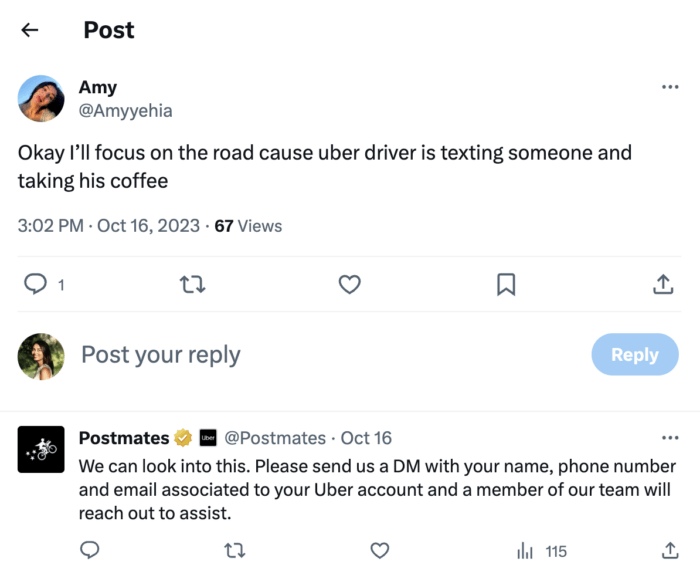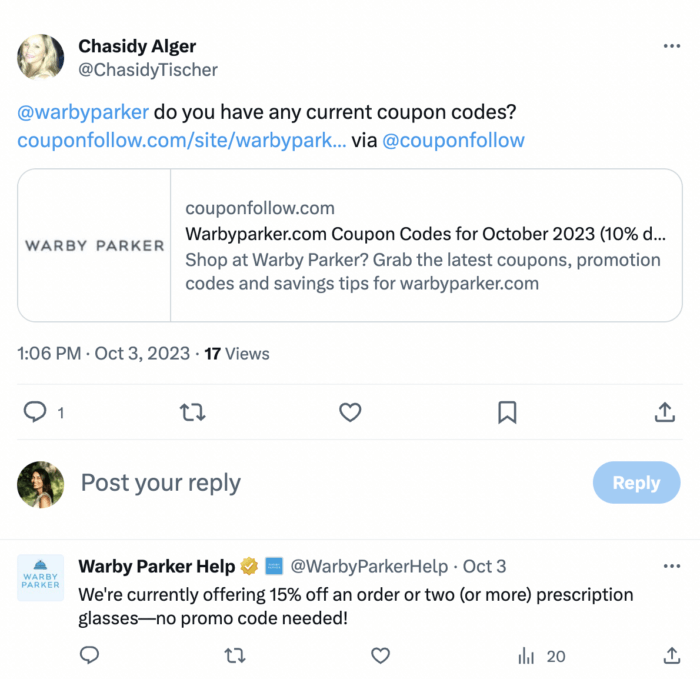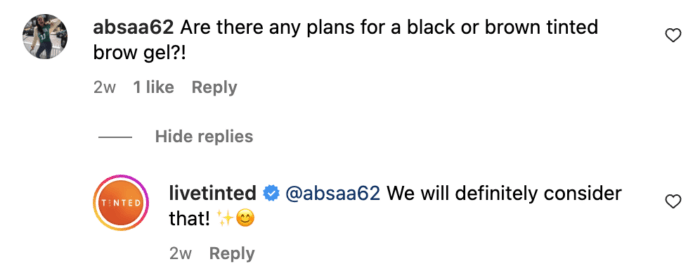Consumers are quick to share their thoughts and opinions online, so it’s important to listen to what they have to say.
All of the data your brand needs to better understand your audience, keep tabs on industry trends, and make better business decisions can be found on social channels — but you need a social listening strategy to help you uncover it all.
Whether you’re new to social listening or need a quick refresher, let’s go over the benefits of integrating it into your marketing efforts and how to create a powerful social listening strategy for your brand.
How to Create a Social Listening Strategy in 5 Steps
Social listening is the process of analyzing and interpreting online conversations relevant to your brand, your product, or your industry even if your brand or product isn’t directly mentioned.
To make sure you’re paying attention to the right conversations, you need a social listening strategy to use as a guide. Keep these key components of a social listening strategy in mind if you want to meet your goals.
1. Set a specific social listening goal
As with any successful strategy, the first step is to set a specific goal that you want your social listening strategy to achieve. Without a goal, your strategy will lack direction and you won’t know where to focus your efforts.
What do you hope to achieve with your social listening strategy? Do you want to better understand your potential customers or do you want to gain insights into industry trends and competitor data? Here are some examples of social listening goals you may want to achieve:
- Improve customer sentiment and experience
- Develop content, product, or marketing ideas
- Discover new audiences to target
- Increase brand partnerships and influencer relationships
If your biggest goal is to improve customer sentiment and experience, then your strategy should focus on gathering as much data on your audience as possible to determine their overall perception and attitude toward your brand. Or perhaps your goal is to find and connect with more influencers. In this case, you could keep your eye on people who organically mention your brand or product — or influencers who mention your competition.
2. Identify the key metrics
Within those goals, there are several social listening metrics you can focus on. The key is to figure out which ones make the most sense to track for the goals you set. At Rival IQ, our top social listening metrics include:
- Sentiment
- Mentions
- Post volume
- Share of voice (SOV)
- Impressions
- Reach
- Engagement rate
While you’ll likely want to track all of these through your social listening efforts, there are some you may want to focus on more than others. For example, if one of your primary social listening goals is to improve brand perception, then you’d want to focus on sentiment analysis in your strategy.
Sentiment analysis involves analyzing posts, mentions of your brand, and online conversations to understand people’s attitudes and general feelings toward your brand. You can do this on a high level or conduct sentiment analysis for individual campaigns or products.
3. Choose a social media tool
To execute your social listening strategy, you need a comprehensive social listening tool that aligns with your goals. No matter how big or small your marketing budget is, there are a range of social listening tools that can be helpful for your strategy. Here are some of our favorite social listening tools:
- Rival IQ: No surprise here, but we have to recommend our own social listening tool. Social listening is integrated throughout the app, which is built through the lens of competitive analysis. If you want to listen to your competition alongside your own brand’s mentions, social conversations, and more, then create a landscape and tap into our social listening capabilities.
- Quid: If you’re looking for an enterprise-level social listening tool, Quid offers comprehensive consumer and market intelligence from all sources of the internet — from social channels to forums and blogs to news sites.
- Mention: Mention monitors online media, brand mentions, and audience insights and compiles everything into one easy-to-track dashboard.
- Twitter (X): Despite the recent changes on Twitter (now X), it remains a valuable tool for staying tapped into current conversations and budding trends.
- Google Alerts: You can use Google Alerts to set up real-time notifications (sent to your inbox) for articles and keywords that mention your brand, your competitors, or anything else you want to track.
Check out this round-up if you’re looking for a more detailed breakdown of the best social media listening tools.
4. Conduct competitive analysis
One of the key differences between social listening and social monitoring is taking a look beyond your own brand mentions and seeing what the competition is doing — and how they’re being perceived — online.
Conduct a competitive analysis to see how your current social channels, online presence, and brand perception compare to similar brands. To get started, think back to your primary social listening goal. If your goal is to improve customer sentiment, then analyze what the overall sentiment is for your competitors. If it’s more positive than yours, dig into what consumers are saying about them. Maybe they applaud their customer service or perhaps people love their mission. Whatever insights you’re able to pick up on, you can use that knowledge to highlight similar elements of your own brand.
5. Create a response plan for social monitoring
If your goal is to improve your brand management and be proactive about potential PR crises, then a response plan is critical. Social listening and social monitoring should work together. This means that your social listening strategy needs to include a plan of action for how your team conducts social monitoring and how your social listening efforts play a role.
For example, the team behind Postmate’s Twitter account responded to this tweet from a concerned customer even though the tweet doesn’t directly mention the brand (note: Uber owns Postmates after acquiring it in 2020). This is a great example of being proactive when it comes to monitoring online conversations to prevent potential crises or backlash.
To stay on top of conversations or comments that involve your brand but don’t directly mention you, compile a list of search terms, keywords, or brand names that you want to monitor. Then, use your social listening tool to track them and be alerted anytime they’re brought up online. Setting up a system like this ensures you and your team can address potential crises or negative conversations before they take off.
Social Listening vs. Social Monitoring
Before you dive into creating your social listening strategy, it’s important to understand the difference between social listening and social media monitoring.
As we mentioned earlier, social listening involves tracking and analyzing online conversations, even if your brand or product isn’t directly mentioned. Social monitoring is when you keep tabs on direct mentions or tags of your brand.
While the two go hand in hand, the key differences between listening and monitoring are perspective and context. Social monitoring is important for real-time actions and direct communication such as responding to customer service questions or concerns. Social listening, on the other hand, is about reading between the lines and translating relevant online conversations into actionable takeaways.
To give you a better idea of how this works, take a look at this interaction between Warby Parker and a customer. Customer inquiries like this are common on Twitter and Warby Parker is quick to ensure customers have access to a discount code they can use right away. Warby Parker’s prompt response is an example of social media monitoring in action.
Social listening comes into play if Warby Parker were to take a look at recent customer interactions and identify patterns or opportunities to better understand customer sentiment. For example, a social listening strategy could help Warby Parker notice that questions about discounts come up often. To solve this, the glasses brand could make their discounts more discoverable to Twitter users by adding a discount code to their bio or pinning a tweet at the top of their page.
Social listening is about understanding brand perception and customer sentiment and acting on those findings.
The Benefits of Social Listening
As a data-driven marketer, social listening should be integrated into your overall marketing strategy. Social listening not only guides your actions and content on social but also helps you uncover data related to your target audience, industry trends, brand perception, and more. Here are some ways that your brand can benefit from a social listening strategy.
Audience insights
One of the biggest benefits of social listening is that it helps you get to know your audience on a deeper level. When you listen to online conversations your audience is having, you can pick up on their language, interests, and behaviors beyond the surface-level feedback you may get through direct interactions like mentions and comments.
For example, using Rival IQ’s social listening tool, we can see the popular terms, phrases, and emojis used in posts about Fenty Beauty. It’s no surprise that Fenty’s famous founder is mentioned the most in people’s posts, but we can also see that the term “NEW” is used often, too. This could indicate that Fenty’s customers and fans tend to be excited and post more when a new product launches.
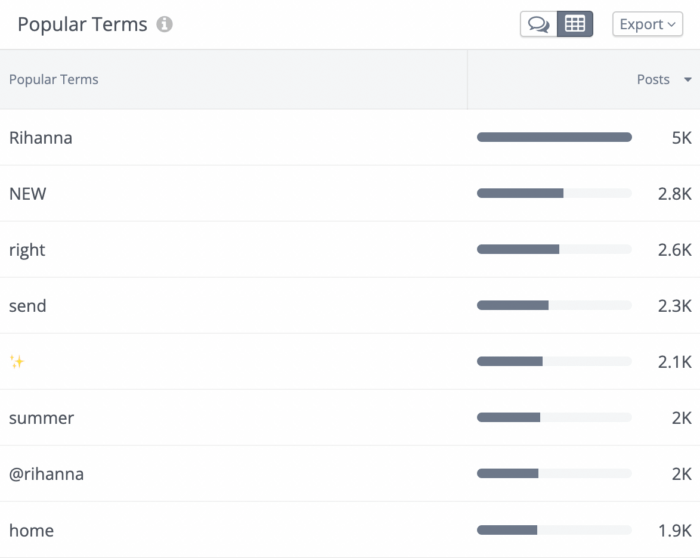
What’s helpful about Rival IQ’s social listening tool is that you can also see which emojis are most used in your audiences’ posts. This not only gives you a sense of the general sentiment around your brand, but also lets you know how your audience talks online. You can then use this to inform the tone of your own content so you can interact with your followers in a way that resonates with them.
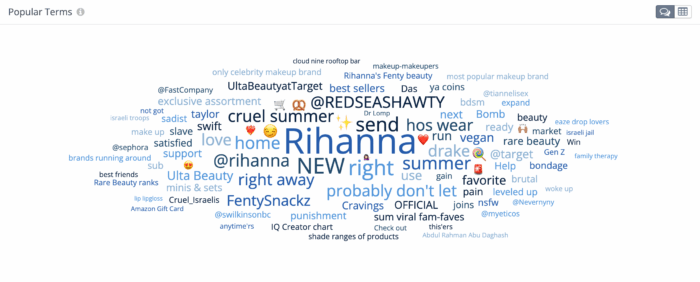
Campaign measurement
You can also use social listening to measure the success of a campaign, whether you’re launching a new product, announcing a partnership, or hosting an event. While the engagement on your campaign posts gives you a sense of how your followers feel, direct interactions don’t always tell the whole story. Social listening can help you understand the overall sentiment around a marketing campaign based on online conversations that might not directly mention your brand.
For example, let’s take a look at the sentiment around some of Fenty Beauty’s recent campaigns. Below is a word cloud for Fenty Beauty generated in Rival IQ’s social listening tool. The terms are shown in either green or red to represent positive and negative sentiments, respectively. A quick glance reveals that some of the biggest terms (the size indicates the number of posts that contributed to them) revolve around makeup and specific products.
If we look closer, we can also see that terms like “come to Target” drove positive sentiment. This specific term correlates with the announcement that Fenty Beauty launched in Ulta Beauty at Target on October 1st. The teams at Target, Ulta Beauty, and Fenty, could tap into their social listening tool to see that this campaign resonated positively online.
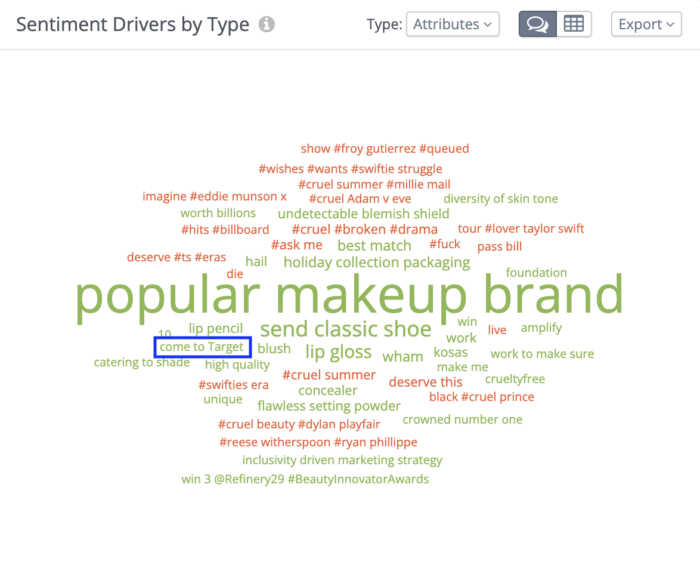
Another campaign that yielded positive reactions is Fenty’s Holiday Collection, specifically the packaging. The term “holiday collection packaging” is listed above as a term with positive sentiment. When we dig deeper into that term, we can see that there were 30 posts in a 30-day period that contributed to the sentiment, all of which are positive. Fenty’s marketing team could then lean into that sentiment by highlighting the packaging when marketing the holiday collection.
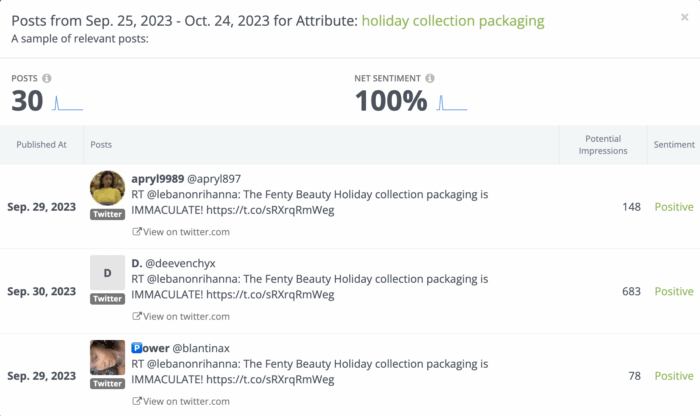
Product development
Listening to conversations online is a great way to inform your product development. There are a couple of ways to do this. One way is to take note of what your followers constantly ask about or mention in your posts. For instance, in the comment section under one of Live Tinted’s Instagram posts, a follower asks if the beauty brand plans on releasing a tinted brow gel. If Live Tinted didn’t already have this in the works, seeing frequent comments like this would prove that they probably should.
You can also use your social listening tool to see what ideas come up online. Using that same Fenty Beauty example above, we can see that “lip pencil” is one of the positive words that drives positive sentiment when people talk about the brand. Fenty Beauty doesn’t currently carry a lip pencil, so this could indicate that people are interested in one from the beauty brand.
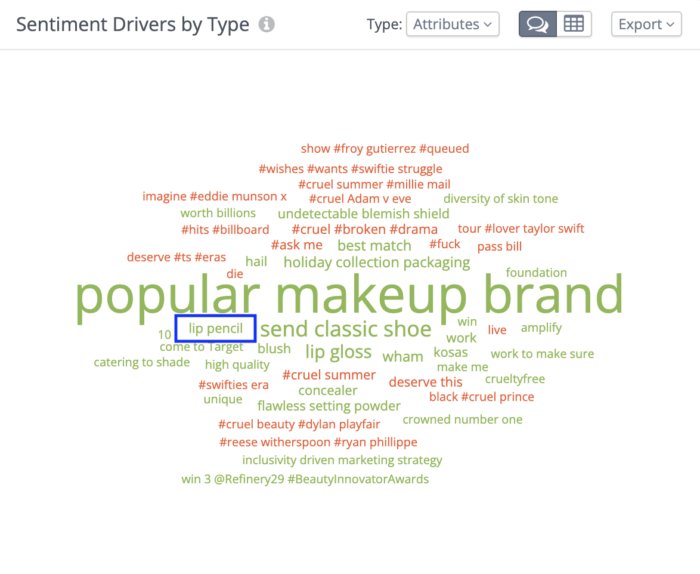

Tap into powerful social listening insights with Rival IQ.
Start your free trialIndustry trends
Social trends come and go within a day or two, so it can be a challenge to stay on top of them if you’re a solo marketer or on a small team, let alone decide whether or not to participate. Social listening tools can help with this by gathering data on industry trends so you don’t have to do all of the research yourself.
The data below shows the trending topics and hashtags used by brands in the beauty industry. Discovering these trending hashtags and topics can help you identify potential content ideas. For instance, one of the most engaging hashtags in this set is #ASMRUnboxing with a 23.3% engagement rate by follower.
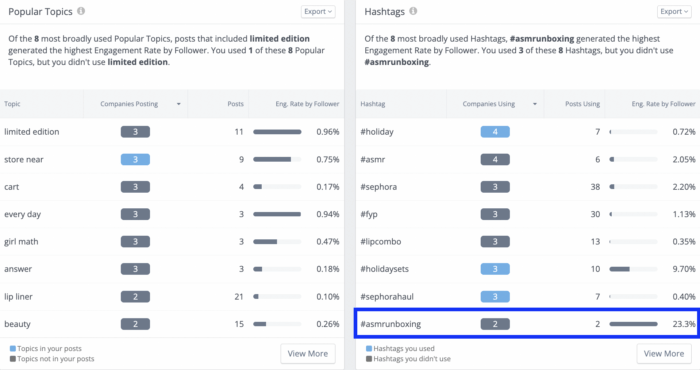
ASMR (autonomous sensory meridian response) is the tingling sensation that can be triggered by soft noises like whispers and has been popularized by YouTube and TikTok creators. Here’s an example of an ASMR unboxing video:
As a beauty brand marketer, you could use this insight to create your own ASMR unboxing content for TikTok, Instagram, or YouTube. You could also partner with one of these ASMR creators and send them a box of products for them to feature in their own videos like the one above.
Identify influencers and brand partnerships
Another benefit of having a social listening strategy is being able to identify potential partnerships. You may already have an eye on influencers who align with your brand, product, or industry, but you likely found them organically or through outreach. Social listening helps you discover people who may not already be on your radar.
For example, let’s say you want to generate buzz around a new pumpkin spice-flavored lip balm launching in the fall. You can use a tool like Rival IQ to search for the term “pumpkin spice” to see if there are influencers who mention it in their content and could potentially be a good fit to promote your new product. You can also see which brands mention the term a lot. This can help you identify potential competitors or partnerships, depending on the industry they’re in.
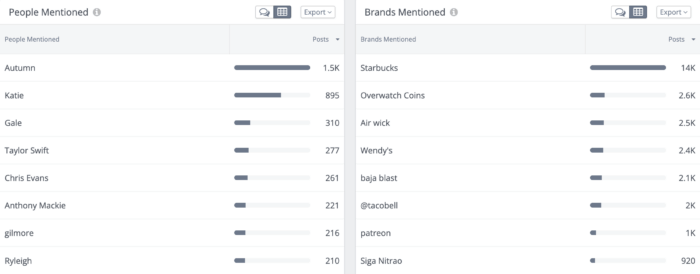
Keep tabs on the competition
The same methods you use for your own social listening strategy can be employed for your competitors. Use social listening to stay on top of what similar brands are doing in regard to product development, customer relations, and marketing strategy. You can also identify opportunities to differentiate your brand from the rest.
To do this, you can organically track what the competition is doing online, or you can use a social listening tool that automatically collects and analyzes data from your competitors. Tracking their activity and data alongside your own brand monitoring helps you get side-by-side insights into how you’re performing in relation to similar brands in your industry.
Here’s an analysis of Live Tinted’s social media posting activity compared to other beauty brands. The visual breakdown of posts per week and on which channels could help Live Tinted decide where to focus their efforts if they wanted to match the posting frequency of their competition.

Social Listening Strategy Best Practices
A social listening strategy is only as good as you make it — as in, it’s not enough to just create a strategy and let it work on its own. As you’re putting your social listening strategy into action, keep these best practices in mind to get the most out of your efforts.
Set up alerts
Online conversations move fast. As soon as a trend, conversation, or sentiment is out there — good or bad — it can easily gain traction. The only way to ensure your brand stays ahead of these conversations is to get real-time notifications about changes or trends within your industry. You can set up Google Alerts for your brand name, competitor brands, or industry topics to get notified as soon as something newsworthy crops up.
If you use Rival IQ, you can also set up custom alerts that are delivered straight to your inbox. You can set up alerts for a range of updates that are important to you including stand-out posts, trending topics and hashtags within your industry, or even when your competitors change their bio.
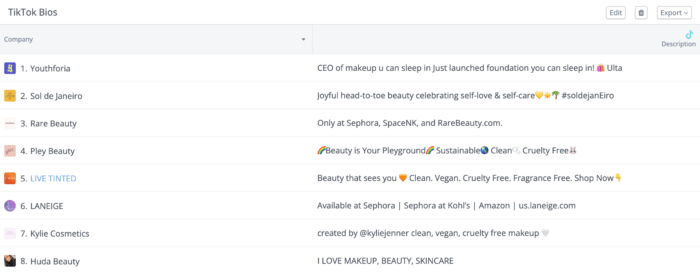
Filter out the noise
As important as social listening is to a brand’s marketing success, you don’t need to tune into *everything* that’s being said online. One key to effective social media listening is understanding how to hone in on the important metrics and filter out the rest.
What you focus on and what you choose to filter depends on your social listening goals. For example, maybe one of your goals is to find new audiences to reach. If your current audience spends a lot of time on Twitter, then you probably don’t want to analyze data from that channel for this particular goal. You could filter that data out and instead focus on YouTube or forums.
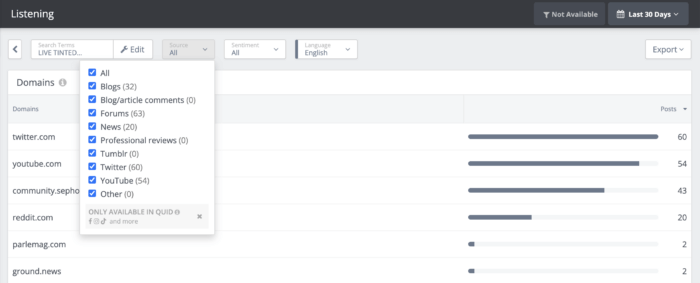
Measure your results
Like the rest of your social media strategy, your social listening efforts should always be measured. Use your original objective and KPIs to track your results and determine if you’re meeting your goals or if you need to make adjustments.
If your goal was to improve customer sentiment over a set period of time, then track your progress month to month. In Rival IQ, you can track your brand’s net sentiment per day which helps you visualize how the sentiment around your search terms has changed over time.
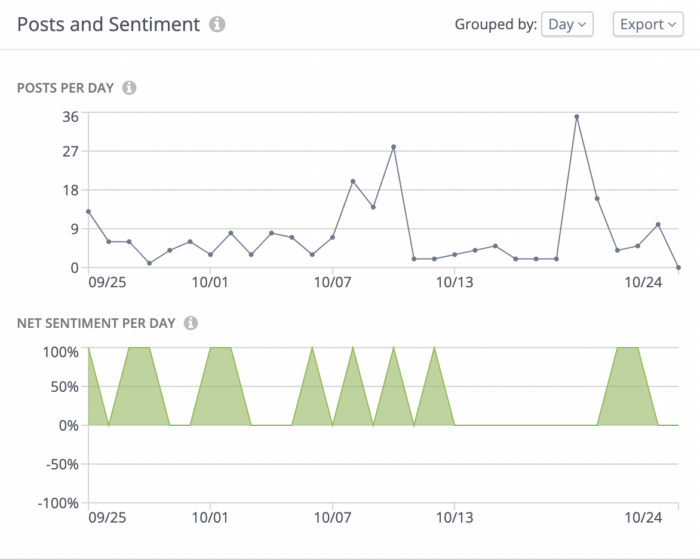
Wrapping it Up
A social listening strategy is essential for every brand. When social listening is done right, it not only impacts your social performance but also informs your overall marketing strategy and can influence major business decisions. For social listening to be effective, you have to take an active role by setting specific goals, identifying the KPIs that you want to measure, and regularly monitoring and analyzing online conversations. The data is there — you just have to know what to listen for.

